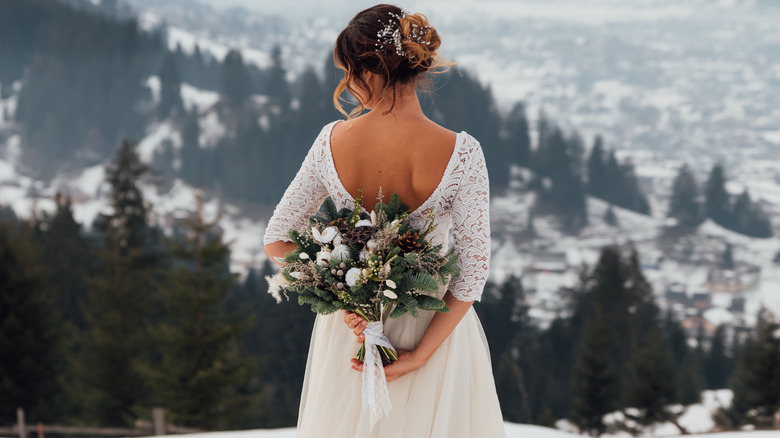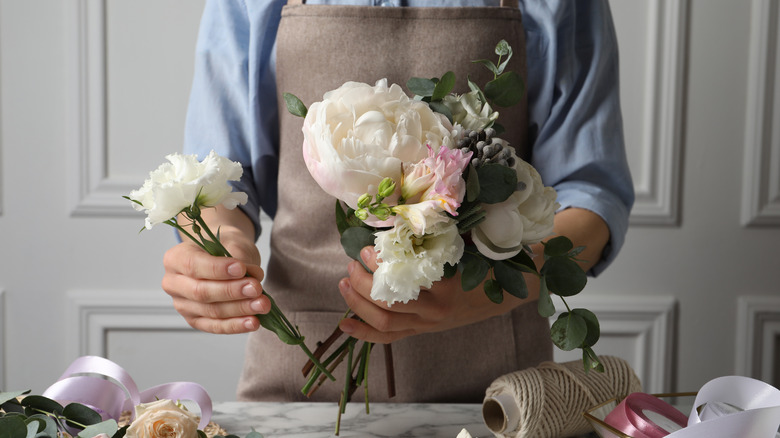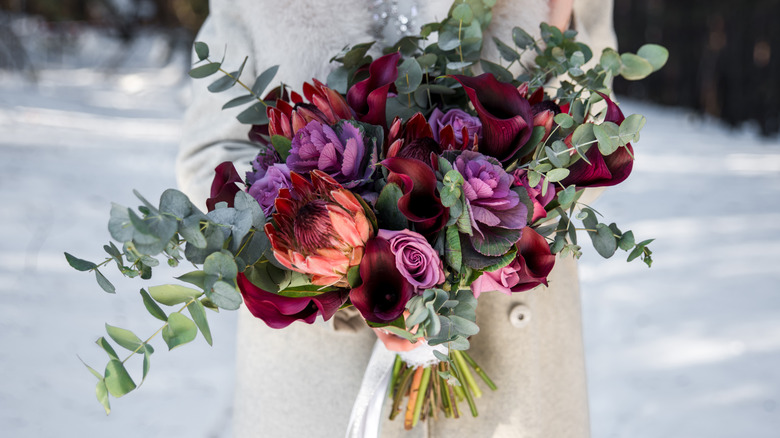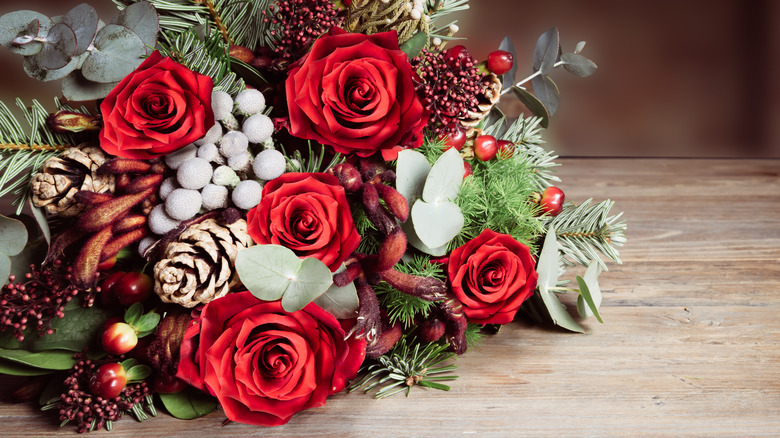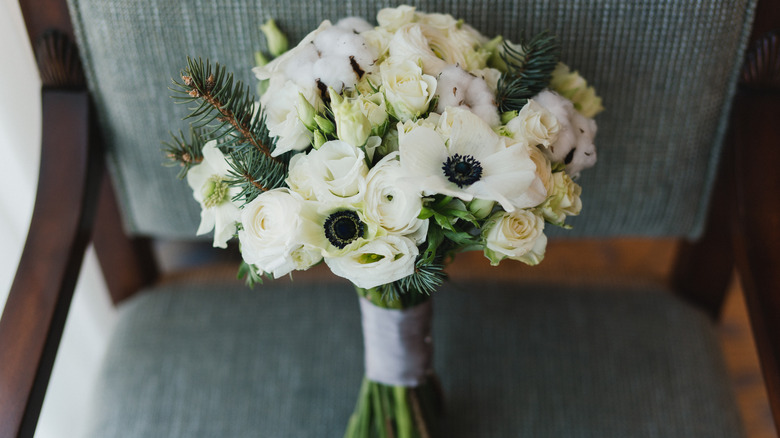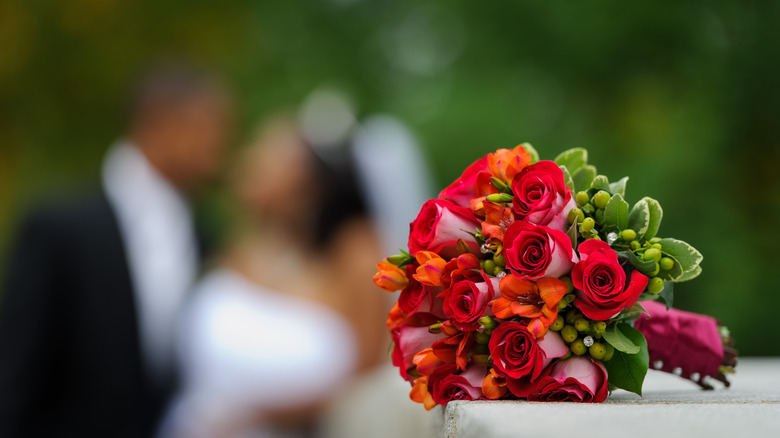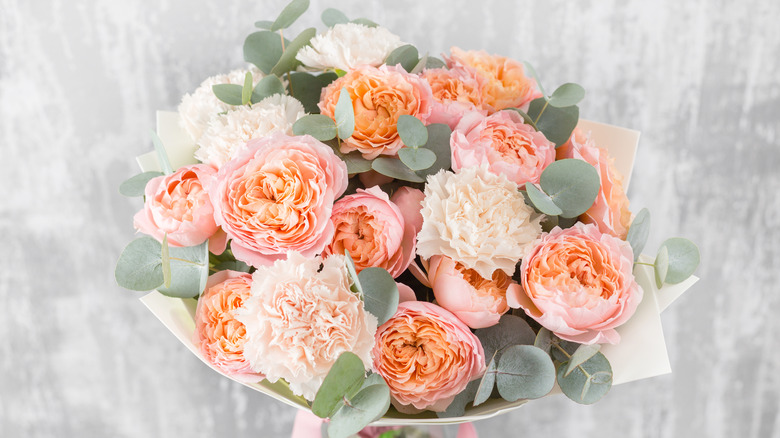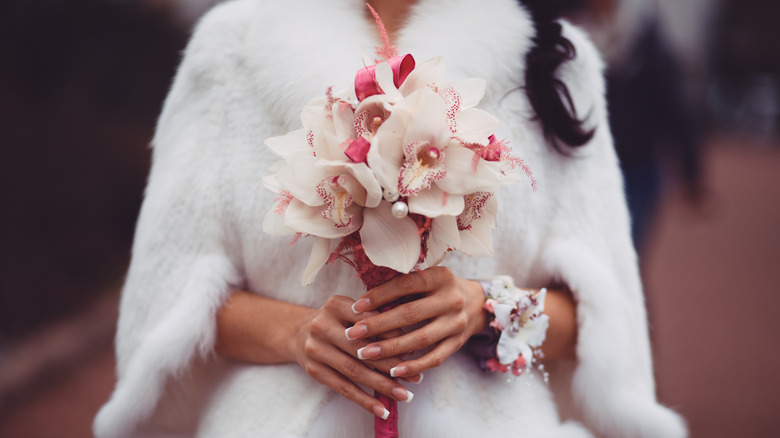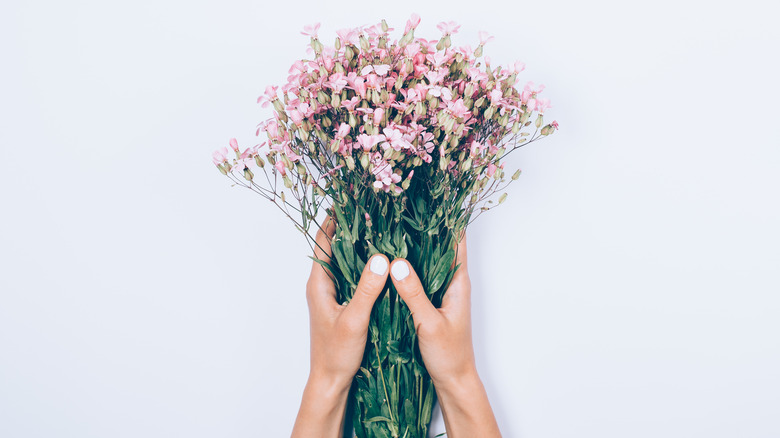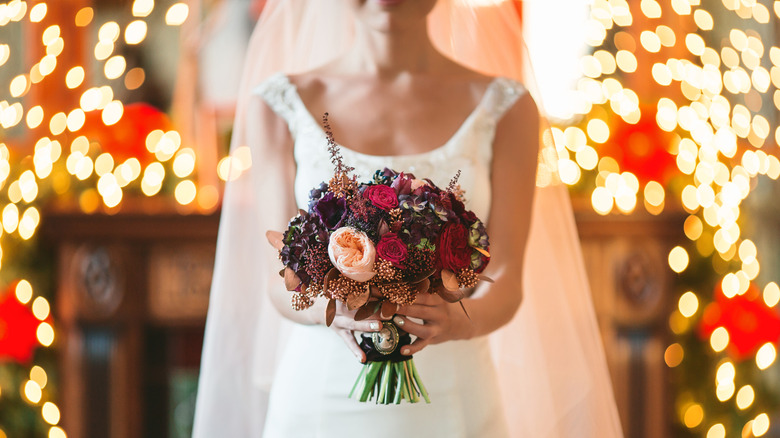The Best Flowers To Use For Winter Bridal Bouquets
Just got engaged? Stressed about your wedding timeline? There are so many little details to consider when planning your big day. Not to mention the cost — weddings are not easy on the wallet. There are so many decisions to be made, including figuring out in which season the wedding will take place. Many brides may be hesitant to have a winter wedding because of the cold weather, but there are so many perks to having your wedding during the colder months.
The weather can even be an advantage when it comes to planning. Usually, winter weddings take place inside, eliminating the chance of unexpected rain or storms. The winter weather and snow can even make a beautiful backdrop for first-look and bridal party pictures. According to Brides, the lack of humidity is a benefit of having a winter wedding. Guests won't complain about sitting in the sweltering heat during a long ceremony, the bride and bridal party's makeup will stay on longer, and the winter is a great time to have black-tie attire.
So you want to have a winter wedding? There are so many design choices that will really elevate your entire theme. One of those details is your bridal bouquet. This is a make-or-break detail that is just as important as the bridal gown. Having a beautiful bouquet that matches the dress, theme, and color scheme is often a daunting task. Nevertheless, there are many options for winter brides when it comes to florals.
First, decide if you want to hire a professional or create your own bouquet
Bridal bouquets can be costly, so some brides on a budget opt to go the DIY route. However, others choose to outsource the task to a professional florist. Finding one who is eager to work with your vision will help ensure things go smoothly. Thankfully, many resources are available online, including The Knot's search engine, which can help you find available florists in your area.
Whether you opt to use a professional floral designer or DIY your bouquet, research is of utmost importance. If making your own bouquet, you should consider the price and variety of fresh flowers, supplies (like ribbons and pins). If you plan to use a professional, gather reference images and don't forget to consider additional costs like delivery fees and fees associated with using florals that are not in season where you live. Make sure to meet with your floral designer beforehand to discuss their experience and draft a vision for your big day.
Seasonal flowers
Floral arrangements are a major part of every wedding and can end up being very costly if brides and their wedding planners aren't careful about budgeting. Whether you plan on getting married in the winter, spring, summer, or fall, it is important to know which flowers are in bloom that season. Some flowers have shorter blooming seasons, which make them harder to get during a specific month — and therefore more expensive!
Many florists can help you get any type of flower you want during any season, but choosing seasonal flowers is much more cost-effective. It is also important to narrow your search, as there are so many types of flowers to choose from that it can be overwhelming.
Many wedding planning blogs and websites have guides for seasonal flowers – The Knot even details the best flowers for each month. If you're working with a florist, be sure to ask their expert opinion on which flowers will best suit your wedding timeline. Making sure your bouquet can last the whole day and look its best will ensure you don't have any additional stress on your big day.
Festive or winter-themed flowers
Your color scheme will be one of the most important details at your wedding. A color scheme dictates everything from the colors of centerpieces, tablecloths, cake, and, of course, the flowers.
Your color schemes will ideally match the timeline of your nuptuals. For spring and summer weddings, lighter colors (think: pastels) are typically chosen. But if you're stuck on what direction to follow when thinking about winter color schemes, know that some color pairings work best for winter weddings.
If you want to embrace the snowy and wintry feel, choose jewel tones paired with crisp, white shades. This combination of colors will have guests feel like they're in an icy wonderland. If you want to steer clear of white, choose colors that more subtly hint at a winter theme. If your wedding is in December or near the holidays, consider adding pops of red for a festive feel. Shades of plum, crimson, peach, and soft pinks are also popular colors to use during the winter months.
Anemones
Anemones are a popular flower chosen by many winter brides. According to Wedding Wire, the growing season of the anemone falls between October and May, which makes them a viable option for brides getting married during the winter season. Anemones are even known in different cultures to symbolize change, making them perfect for weddings, and symbolizing a new beginning between a bride and her new partner.
Anemones come in an array of colors, including pink, red, burgundy, blush, and purple. However, the most well-known is white. The flower has a black center, which creates a stark contrast with its light-colored petals and creates a sense of drama in any bridal bouquet. A more modern flower, anemones are a great option for contemporary brides looking to add some subtle flair to a bridal bouquet.
As florist Mary Stevens of Fearrington Weddings in Pittsboro, North Carolina, told Wedding Wire, "This flower pairs gorgeously with soft whites and natural greenery to create an aesthetically interesting bouquet that can be more classic or natural, depending on the accompanying blooms"
Roses
Roses are a great option for any bride during any season — they're a flower that can be used year-round, according to Flower Mag. They're popular and easy to get a hold of if you choose to DIY your bridal bouquet. Thanks to the many different species and varieties of roses, they are a versatile option for any bride's wedding.
Roses are also perfect for a variety of different styles of weddings. From modern and contemporary to more traditional and retro and everything in between, there is a way to make roses fit your style. Roses are also among the most popular wedding flowers because of their sweet smell. Many brides enjoy the appeal of this beautiful flower and are eager to include them in their bouquets due to the scent.
Another plus is the wide array of colors you can choose — roses can fit with practically any color scheme. From red and white to blush and dark pink, the options are nearly endless. As an added bonus, roses are a symbol of love in many cultures throughout history. What's better than walking down the aisle with a flower that represents your undying love for your partner?
Carnations
Carnations are frequently used to build winter bridal bouquets. According to Brides, the carnation is a popular flower because it is one of the easiest to take care of. Carnations can last an entire day without water, making these a great option for brides who don't want to have any additional stress added onto their plates on their big day. Because what's better than using worry-free florals? There are so many other little details that can cause brides anxiety on their big day, including dress malfunctions, makeup mess-ups, bridal party woes, and so much more. It also doesn't hurt that carnations are friendly on the wallet. "They are cost-effective, but not cheap looking," florist Teresa Eoff told Brides.
Red carnations are known to be associated with adoration and love, making them the perfect addition to any celebration of marriage. Plus, red carnations will add a festive touch to your winter wedding. If red is not your thing, that's okay — carnations come in a variety of different shades and tones, perfect for creating a multidimensional look. White, blush, and pink carnations can be bunched together to create a luscious and full winter bridal bouquet.
Orchids
Some may be surprised by this recommendation, but orchids shouldn't be considered a spring or summer flower. Orchids can be used year-round and serve as a perfect addition to any bridal bouquet. Although they are versatile and come in various colors and blooms, these flowers aren't very budget-friendly, according to Inside Weddings. Even with a tight budget, though, there are ways to work in this flower. Instead of using all orchids in your bouquet, use them as an accent. Inserting just one or two orchids into a bouquet filled with other flowers will also help to create texture and dimension.
With orchids, there's sure to be a hue to fit your wedding's color scheme — whether that's red, pink, white, blue, green, purple, orange, or yellow. Orchids are most commonly used by wedding florists to create cascading bridal bouquets, which is a beautiful and classic way to incorporate this gorgeous flower into your ceremony.
Baby's breath
Don't dismiss this flower for being cliche. There are many elevated ways to include baby's breath in your winter bridal bouquet. Because baby's breath is so commonly used, it has been looked over by so many brides, according to HGTV. But baby's breath is a cheap way to add filler to your bouquet without overdoing one specific type of flower. Mix white baby's breath with red roses and you have a beautiful wintery bridal bouquet.
Adding this delicate flower to your bouquet will prevent your bouquet from being too visually heavy. Instead, it will add balance with its light, airy blooms. Baby's breath mixes well with romantic themes, soft blush and peach tones, and it can even balance out bold colors you may include in your bouquet, like reds and blues. They create a sort of snowy look that is a perfect addition to any bouquet to make it feel more in-season during the winter.
Pepperberries, eucalyptus, and more
So you've picked your colors scheme and your main flowers. It's now time to add some other elements to really make your bouquet pop. Whether you're working with a florist or creating your own bouquet, the options are endless.
To add a seasonal touch to your winter wedding bouquet, consider adding berries. They can create a sense of winter holiday spirit as well as fill in any extra space within your bouquet for a fraction of the cost of additional flowers. Adding red berries to a white bouquet or even alongside pink and red flowers for a more monochromatic look will help add a different texture as well. Elderberries, Berzelia berries, pepperberries, and Hypericum berries are all great options that add dimension and visual interest to bridal bouquets. If you want something other than berries, why not throw in some ferns, olive branches, eucalyptus leaves, fresh fruit, or other foliage?
There are so many different aspects of floral design to consider when designing your bridal bouquet. Be sure to stay true to your personal style and if working with a florist, communicate your wants so your big day can be the best it can be.
